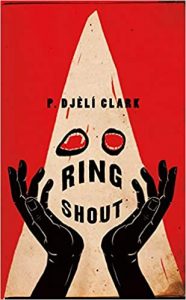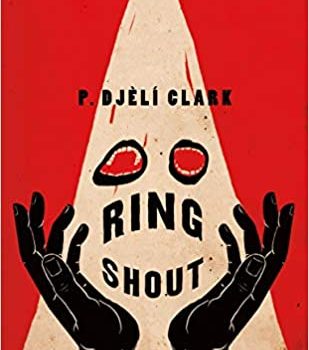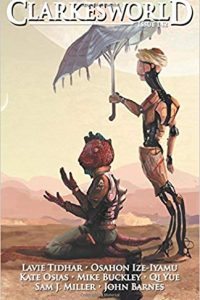Gary K. Wolfe Reviews Ring Shout by P. Djèlí Clark
 Ring Shout, P. Djèlí Clark (Tor.com Publishing 978-1-250-76702-8, $15.99, 176pp, hc) October 2020.
Ring Shout, P. Djèlí Clark (Tor.com Publishing 978-1-250-76702-8, $15.99, 176pp, hc) October 2020.
If there’s such a thing as boisterous folk horror, P. Djèlí Clark’s Ring Shout may set the standard. While it doesn’t directly invoke Lovecraft’s own eldritch critters the way that N.K. Jemisin does in The City We Became or Victor LaValle in The Ballad of Black Tom, it certainly invokes the mythos of Really Ugly Things trying to break into our world to devour all we hold dear, and manages to make Stone Mountain GA at least as foreboding as Arkham or Innsmouth. Clark draws heavily on other traditions as well, ranging from John Carpenter-style body horror (as in They Live, only select people can see the inhuman monsters in their true form, and the monsters can reshape themselves Thing-style) to familiar tales of “Bruh Rabbit” and “Bruh Bear” (the narrator keeps a beloved old book called Negro Folktales), Gullah folklore, and the ringshout tradition of the title, which here can serve as exorcism as much as celebration. At one point, there’s even a hint of Alien, when one of the monsters stretches to nine feet tall, with a head “long and curved to end in a sharp bony point.” While Lovecraft’s odious attitudes have been getting plenty of attention in the past few years, he was a pretty ineffectual racist compared to the offstage villain of Clark’s novella – the pioneering movie director D.W. Griffith, whose 1915 Birth of a Nation actually helped revive and reinvent the Ku Klux Klan, which, as Maryse explains, had fumbled its way to oblivion decades earlier. But, Maryse also explains, those early Klan founders had made their own deal with eldritch forces, with the result that human Klan members (here referred to as Klans) could eventually be transformed into those shapeshifting monsters (or “Ku Kluxes”).
The story is set in 1922, seven years after the controversial premiere of Griffith’s film, which at the time was about the biggest movie event ever. The central characters are a group of monster-hunting women led by the narrator, Maryse Boudreaux, armed with a magical sword given to her by haints; the sharpshooter Sadie; and a World War I veteran nicknamed Chef because of her skill in mixing explosives. All were summoned to Macon by the old Gullah wise woman Nana Jean, who speaks in dense dialect (although other Gullah passages used as chapter heads appear “transliterated”). They gain other allies, such as a self-taught Choctaw biologist named Molly, a transplanted islander named Michael George (Maryse’s love interest), the German socialist and organizer Emma Kraus (also credited as the translator in those chapter heads), and, perhaps most important, three timeless “aunties” who occasionally summon Maryse into a spiritual realm to offer advice. As is clear from the opening chapter, a nonstop action sequence during a Fourth of July Klan parade, Maryse’s team is on the front line. Their immediate opponent is a terrifying figure named Butcher Clyde, who introduces himself to Maryse in a dream as “the storm on the horizon” and has just opened a new butcher shop in Macon, offering “free meats” to all white patrons, which turns out to be just as ominous as it sounds. Among other tricks, Clyde occasionally breaks out in revolting skin lesions that turn into hundreds of tiny mouths. Even more ominous is the Klan’s scheme to host a giant rally for the re-release of Birth of a Nation, which is to be projected on the side of Stone Mountain. The real purpose of the rally, of course, isn’t just to stage the world’s worst drive-in, but to summon something called the Grand Cyclops, sort of a Cthulhu for crackers, leading to an inevitable epic confrontation with Maryse and her crew.
There’s always a balancing act when an author chooses to invoke a system of supernatural horror in the context of lived horrors such as the Klan or systemic racism; readers might reasonably ask if one is in danger of overshadowing or diluting the other – an issue faced, in different ways, by authors as diverse as Victor LaValle, Matt Ruff, and N.K. Jemisin. Clark rather ingeniously introduces a second system of supernatural power to counter the evils of Butcher Clyde and the Klan, and grounds it fully in the folklore of haints and Gullah magic, most clearly embodied in Maryse’s “aunties.” Thus, Maryse’s magic sword in the astral world parallels Sadie’s rifle in the streets of Macon, where street-level Klan members come across largely as clueless dupes to be manipulated by Clyde and his associates. Still, Clark does a brilliant job of grounding his spectacle in a convincing and unnerving portrait of the 1920s South, with a few chilling instances of the real costs of racism. What may be more important is how he does this without forgoing the energetic, almost cheerfully musical celebration of the power of resistance and belief.
Gary K. Wolfe is Emeritus Professor of Humanities at Roosevelt University and a reviewer for Locus magazine since 1991. His reviews have been collected in Soundings (BSFA Award 2006; Hugo nominee), Bearings (Hugo nominee 2011), and Sightings (2011), and his Evaporating Genres: Essays on Fantastic Literature (Wesleyan) received the Locus Award in 2012. Earlier books include The Known and the Unknown: The Iconography of Science Fiction (Eaton Award, 1981), Harlan Ellison: The Edge of Forever (with Ellen Weil, 2002), and David Lindsay (1982). For the Library of America, he edited American Science Fiction: Nine Classic Novels of the 1950s in 2012, with a similar set for the 1960s forthcoming. He has received the Pilgrim Award from the Science Fiction Research Association, the Distinguished Scholarship Award from the International Association for the Fantastic in the Arts, and a Special World Fantasy Award for criticism. His 24-lecture series How Great Science Fiction Works appeared from The Great Courses in 2016. He has received six Hugo nominations, two for his reviews collections and four for The Coode Street Podcast, which he has co-hosted with Jonathan Strahan for more than 300 episodes. He lives in Chicago.
This review and more like it in the October 2020 issue of Locus.
 While you are here, please take a moment to support Locus with a one-time or recurring donation. We rely on reader donations to keep the magazine and site going, and would like to keep the site paywall free, but WE NEED YOUR FINANCIAL SUPPORT to continue quality coverage of the science fiction and fantasy field.
While you are here, please take a moment to support Locus with a one-time or recurring donation. We rely on reader donations to keep the magazine and site going, and would like to keep the site paywall free, but WE NEED YOUR FINANCIAL SUPPORT to continue quality coverage of the science fiction and fantasy field.
©Locus Magazine. Copyrighted material may not be republished without permission of LSFF.






